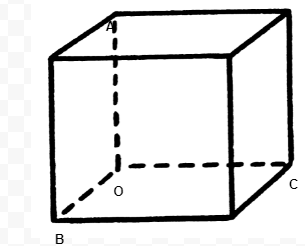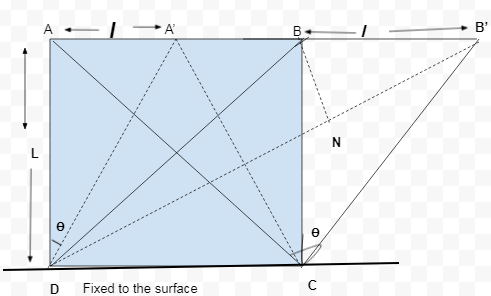Relation Between Elastic Constants - A Complete Guide
Key points of this article:-
- Elastic constant
- Relation between young’s modulus and bulk modulus
- Relation between modulus of elasticity and modulus of rigidity
- Relation between young's modulus, bulk modulus and Poisson’s ratio
- Relation between young's modulus and shear modulus
- Relation between young’s modulus bulk modulus and modulus of rigidity.
- What is elastic constants
- Definition of elastic constant
Now, discuss the elastic constant and their relationship
What is elastic constant:- We can define elastic constant as Elastic constants are constants which tell us the elastic behaviour of materials.
This is the elastic constant definition
There are three elastic constants (or elastic coefficients)
Young’s modulus of elasticity (Y or E) = longitudinal stress / longitudinal strain
Bulk modulus of elasticity (K) = Normal stress/ volume strain
Modulus of rigidity/bulk modulus of rigidity (η or G) = tangential stress/ shearing stress
Poission’s ratio :- The ratio between decreasement per unit length and per unit force and the increasement per unit length and per unit force is called poissions’s ratio.
σ = 1.1.β/1.1.α
Where β = the decreasement in length
α = the increasement in length
Relation between young’s modulus, bulk modulus and Poisson's ratio:-
Let us consider a cube whose side is unit length to derive the relation between Y, K and σ
I.e., OA = OB = OC = 1
So, the volume of the cube
V = 1 (without normal stress)
Also read -
- NCERT Solutions for Class 11 Physics
- NCERT Solutions for Class 12 Physics
- NCERT Solutions for All Subjects
When a normal stress is applied on a every face of cube so the increasement in unit length is α and decreasement is β due to unit force.
So, the side of the cube
OA = 1 + F.1.α - F.1.? - F.1.?
= 1 + F.α - 2F?
= 1 + F ( α - 2? )
So, OA = OB = OC = 1 + F ( α - 2? )
Then the volume of the cube
V’ = OA.OB.OC
= [1 + F ( α - 2? )]³
V’ = [ 1 + 3F ( α - 2? )]
So, change in the volume of the cube
ΔV = V’ - V
= 1 + 3F(α - 2? ) - 1
ΔV = 3F(α - 2? )
And the volume strain of the cube = change in volume/initial volume
= ΔV/V = 3F(α - 2? )/1
= 3F(α - 2? )
And the bulk modulus of elasticity of the cube (K) = normal stress/normal strain
= Force/area/ΔV/V = F/1/3F(α - 2? )
K = 1/3(α - 2? ) = 1/3α(1 - 2?/α)
= 1/α/3(1 - 2σ) ( ∵ σ = β/α)
K = Y / 3 ( 1 - 2σ)
∵ Y = long. stress/long. Strain
Y = F/A/Δl/l = F/1/F.1.α/1 = 1/α
| Y = 3K( 1 - 2σ) |
……(A)
Relation between E and K is
E = 3K( 1 - 2σ)
This is the relation between elastic constants- relation between young modulus and bulk modulus and poisson ratio/ relation between bulk modulus and young’s modulus.
Related Topics Link, |
Relation between relation between young's modulus and modulus of rigidity
For derive the relation between elastic constants - Young’s modulus (Y), modulus of rigidity (η) and the poission’s ratio. Considered a face of cube ABCD side of this face is L. Fixed the side CD and applied the tangential stress (T) on the side AD due to to this A and B point is displaced linearly (l) distance and angularly ? angle and obtained a new position A’ and B’.
So, tangential stress on the side AB
T = force/area = F/L²

And shearing strain
tan? = l/L
But ? is very small tan? ∝ ?
? = l/L
So, the modulus of rigidity of face ABCD
η = T/?
η = F/l²/l/L
η = F/lL …..(i)
NCERT Physics Notes:
Due to tangential stress T diagonal BD of ABCD face changes to B’D. To determine the change of diagonal BD to B’D a perpendicular line is drawn which cut at N point. In this position, NB’ diagonal represent the increment in the B’D diagonal.
In ΔBNB’
Cos45° = NB’/BB’
NB’ = lcos45°
NB’ = l/√2 ….(ii)
This eqn shows that the increment in the diagonal
Due to tangential stress T increments in the BD diagonal and decrement in AC diagonal. Due to unit force increment and decrement in unit length is represented by
α and β.
Due to tangential stress T increasement in BD diagonal = T.BD.α
= F/L².L√2.α
= F/L.√2.α
Due to tangential stress T decreasement in AC diagonal = T.AC.?
= F/L².L√2.?
= F/L.√2.?
So, the total change in the diagonals of ABCD face = F/L.√2.α + F/L.√2.?
= F√2/L (α + ? ) ….(iii)
From equation (ii) and (iii)
l/√2 = F√2/L (α + ? )
F/lL = 1/2(α + ? )
F/lL = 1/2α(α + ?/α) (∵ σ = ?/α)
F/lL = 1/2α(1 + σ)
From eqn (i)
η = 1/α/2(1 + σ ) ( ∵ Y = 1/α)
η = Y/2(1 + σ )
| Y = 2η(1 + σ) |
…….(B)
This is the relation between young modulus and shear of modulus ( or modulus of rigidity ).
And the relation between young’s modulus modulus of rigidity and Poisson’s ratio/ relation between young's modulus and poisson's ratio.
Relation between E and G is
E = 2G(1 + σ)
This is the relation between elastic constants- relation between young’s modulus and rigidity modulus
Relation between Bulk modulus, Modulus of rigidity and Poisson’s ratio:-
From eqn (A) and (B)
2η(1 + σ) = 3K(1 - 2σ)
2η + 2ησ = 3K - 6Kσ
6Kσ + 2ησ = 3K - 2η
σ( 6K + 2η) = 3K - 2η
| σ = 3K - 2η/6K + 2η |
………(C)
Also read :
- NCERT notes Class 11 Physics Chapter 9 Mechanical Properties of Solids
- NCERT solutions for Class 11 Physics Chapter 9 Mechanical Properties of Solids
- NCERT Exemplar Class 11 Physics Solutions Chapter 9 Mechanical Properties of Solids
This is the relation between bulk modulus of elasticity, poission’s ratio and modulus of
elasticity/ relation between elastic constants.
Relation between Young’s modulus bulk modulus and modulus of rigidity:-
From eqn (A)
Y = 3K ( 1 - 2σ )
Y/3K = 1 - 2σ
σ = 1/2 - Y/6K …….(a)
From eqn (B)
Y = 2η(1 + σ)
Y/2η = (1 + σ)
σ = Y/2η -1 ………(b)
From eqn (1) and (2)
1/2 - Y/6K = Y/2η -1
Y/2η + Y/6K = 1/2 + 1
Y[ 1/2η + 1/6K] = 3/2
Y/2 [1/η + 1/3K] = 3/2
| 3/η + 1/K = 9/Y |
……(D)
or, Y = 9Kη/3K + η
This is the relation between elastic constants Young’s modulus, bulk modulus and modulus of rigidity.
Relation between E, G and K Young’s modulus, Bulk modulus and Modulus of rigidity is
E = 9KG/3K + G .
These are the elastic constant formula and elastic constants relation.
Also check-